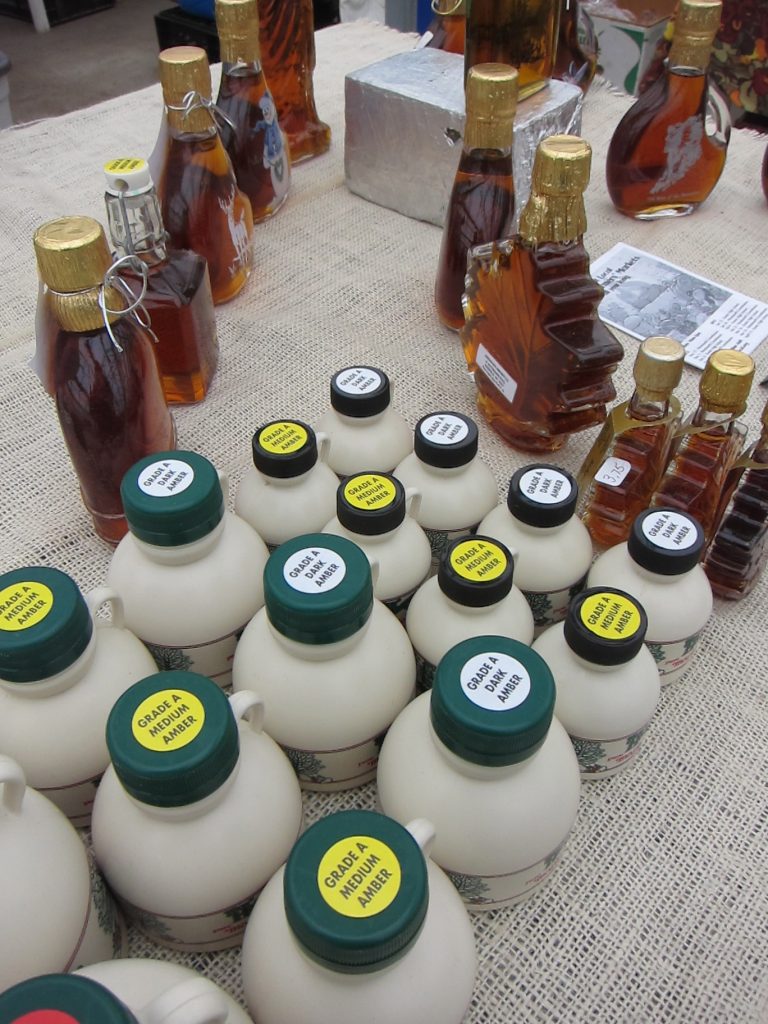 The featured food of our March 23rd Winter Farmers’ Market in Rollinsford is maple syrup — Anderson’s Mini-Maples, Sugarmomma’s Maple Farm, and White Gate Farm will all be bringing ample supplies for you to stock up with. Also this weekend, NH Maple Weekend and Maine Maple Sunday!
The featured food of our March 23rd Winter Farmers’ Market in Rollinsford is maple syrup — Anderson’s Mini-Maples, Sugarmomma’s Maple Farm, and White Gate Farm will all be bringing ample supplies for you to stock up with. Also this weekend, NH Maple Weekend and Maine Maple Sunday!
Maple production in North America has a long history dating before recorded histories of the earliest European settlers. Its beginnings are credited to the earliest settlers, the Indian tribes of southeastern Canada and the northeastern United States, including the Micmac and Iroquois tribes. Back then, maple sap was boiled beyond the point of syrup that we see today to a sugar form, which was much easier to store and trade. Today, the excess starch stored in the sapwood of maples is harvested once the wood temperatures reach around 40 degrees F; this causes the starches to change to sugars, which then passes into the tree sap.
The maple sugaring season in New Hampshire and southern Maine usually lasts about six weeks from mid-February to mid-April, depending on the location and the climate. When nighttime temperatures are below freezing and daytime wind chill temperatures rise to 35 F or more, the sap begins to run. It will not run every day if weather conditions are not right. Ideal conditions for good sap runs occur on sunny days with little wind and temperatures in the 40s after a night of temperatures in the 20s. Maple syrup is produced when the sap of the maple tree is boiled down to the density of syrup. Nothing is added, and only water is removed. It takes approximately 40 gallons of sap from a sugar maple to make one gallon of maple syrup.
Grades of Syrup:
• GRADE A LIGHT AMBER: The first runs of maple sap in the early spring make the Grade A Light Amber syrup. This treasured syrup, with its delicate maple flavor, is used to make maple cream, candy and sugar. Many prefer it as a table syrup.
• GRADE A MEDIUM AMBER: Gradually, as the maple season progresses, the syrup darkens a shade to Grade A Medium Amber. This product bears a richer maple flavor and is great for pouring over pancakes, ice cream or oatmeal. This grade is also used for making maple cream and sugar.
• GRADE A DARK AMBER: Nearing the end of the 4-6 week season, the syrup darkens again to Grade A Dark Amber, which is also a choice table syrup. With its stronger, more robust maple flavor, it can also be used for cooking.
• GRADE B: At the very end of the season, maple producers make a small amount of Grade B syrup, which is darker yet and has a strong maple flavor. Some folks enjoy it as a table syrup; it is primarily used in cooking.
Cooking: All grades of syrup are processed alike and have the same density. Pure maple syrup is a wonderful ingredient to use in your favorite recipe as a substitute for white sugar. Substituting Maple Syrup for granulated sugar: Instead of 1 cup of granulated sugar in recipes, use ¾ cup of maple syrup. In baking, reduce the liquid by 2-4 tablespoons per 1 cup maple syrup used, add 1/4 tsp baking soda, and reduce the oven temperature by 25 degrees.
Maple syrup is 100% natural and contains calcium, zinc, antioxidants, riboflavin, and niacin. It can be used in a variety of desserts and baked goods as well as complimenting sour or salty ingredients in salad dressings, glazes for meat, poultry and fish.
Recipes: Check out the recipes on the NH Maple Producers’ Association website, as well as Sauteed Maple Syrup Apples, Maple Rum-Glazed Chicken, Maple Mousse, or any of these maple syrup recipes we’ve collected for you!
